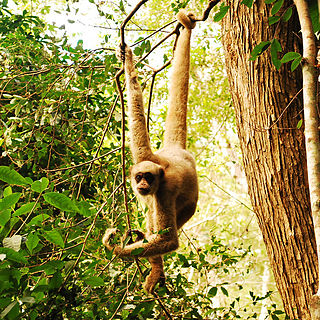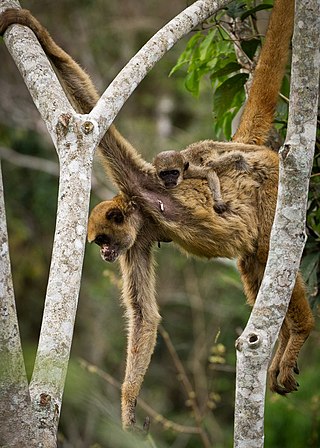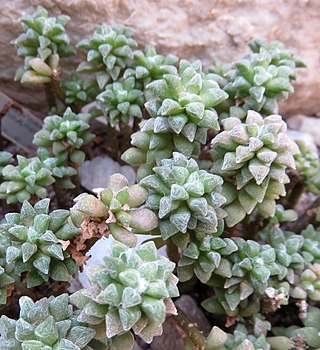Related Research Articles

The Portulacaceae are a family of flowering plants, comprising 115 species in a single genus Portulaca. Formerly some 20 genera with about 500 species, were placed there, but it is now restricted to encompass only one genus, the other genera being placed elsewhere. The family has been recognised by most taxonomists, and is also known as the purslane family. It has a cosmopolitan distribution, with the highest diversity in semiarid regions of the Southern Hemisphere in Africa, Australia, and South America, but with a few species also extending north into Arctic regions. The family is very similar to the Caryophyllaceae, differing in the calyx, which has only two sepals.

The muriquis, also known as woolly spider monkeys, are the monkeys of the genus Brachyteles. They are closely related to both the spider monkeys and the woolly monkeys. The two species are the southern and northern muriquis. They are the two largest species of New World monkeys, and the northern species is one of the most endangered of all the world's monkeys.

The northern muriqui is one of two species of muriqui. They are also known as woolly spider monkey because they exhibit the woollen pelt of woolly monkeys and the long prehensile tail of spider monkeys. Muriquis are the largest extant New World monkeys. They can reach 4.3 feet or 1.3 metres long and weight up to 7 to 10 kilograms. The northern muriqui is a critically endangered species that is unusual among primates in that they display egalitarian tendencies in their social relationships. This species is endemic to the Atlantic Forest region of Brazilian states of Rio de Janeiro, Espírito Santo, Minas Gerais and Bahia. Their diets, travel patterns and reproductive cycles are seasonally determined. The size of each group can fluctuate as females will move between groups of monkeys.

The southern muriqui is a muriqui species endemic to Brazil.

Calymene Brongniart, 1822, is a genus of trilobites in the order Phacopida, suborder Calymenina, that are found throughout North America, North Africa, and Europe in primarily Silurian outcrops. Calymene is closely related to Flexicalymene, and both genera are frequently found enrolled. Calymene trilobites are small, typically 2 cm in length. The cephalon is the widest part of the animal and the thorax usually has 13 segments.

Arachnoides is a genus of sea urchin within the family Clypeasteridae, found in the Indo-Pacific oceans. The base is flat and the upper surface is convex.
Libinhania arachnoides, synonym Helichrysum arachnoides, is a species of flowering plant in the family Asteraceae. It is endemic to Socotra. Its natural habitat is subtropical or tropical dry forests.

The spider tortoise is a species of tortoise in the family Testudinidae that is endemic to Madagascar and is one of only two species in the genus Pyxis.

AnacampserosL. is a genus comprising about a hundred species of small perennial succulent plants native to Southern Africa, Ethiopia and Latin America. The botanical name Anacampseros is an ancient one for herbs supposed to restore lost love.

Pyxis is a genus of tortoise in the family Testudinidae. It contains the following species:
Macfarlandia arachnoides is a species of beetles in the family Cicindelidae, the only species in the genus Macfarlandia.
Ammotrophus arachnoides is a species of sand dollar of the family Arachnoididea. Their external skeleton, known as a test, is covered with spines. It belongs to the genus Ammotrophus and lives in the sea off southern Australia. Ammotrophus arachnoides was first scientifically described in 1938 by Hubert Clark.

Arachnoides placenta is a species of sea urchin of the family Clypeasteridae. Their armour is covered with spines. It is placed in the genus Arachnoides and lives in the sea. Arachnoides placenta was first scientifically described in 1758 by Carl Linnaeus.

Arachnoides tenuis is a species of sea urchin of the family Clypeasteridae. Their armour is covered with spines. It is placed in the genus Arachnoides and lives in the sea. Arachnoides tenuis was first scientifically described in 1938 by Hubert Lyman Clark.
Eremophila arachnoides is a plant in the figwort family, Scrophulariaceae and is endemic to a few arid areas of Western Australia and South Australia. It is a little-known, broom-shaped shrub with white to mauve, trumpet-shaped flowers which are densely hairy on the inside.

Clypeasteridae is a family of sea urchins in the order Clypeasteroida. This family was first scientifically described in 1835 by the Swiss-American biologist Louis Agassiz.

Anacampseros arachnoides is a species of succulent plant native to the Little Karoo region of South Africa.

Anacampseros albidiflora is a species of succulent plant native to the Great Karoo and Little Karoo regions of South Africa.

Leptospermum arachnoides, commonly known as the spidery tea-tree, is a species of shrub that is endemic to eastern Australia. It has rough bark, crowded linear to lance-shaped leaves with a sharp point on the end, white flowers and hairy fruit.
Heikeopsis arachnoides is a species of the genus Heikeopsis first described by Manning and Holthuis in 1986. These crabs are native to Japan. They typically live in the sand 15-130m below the surface of water. Heikeopsis arachnoides also lives in Taiwan.
References
- ↑ Biolib.cz - Tessarecphora arachnoides. Retrieved on 8 September 2014.